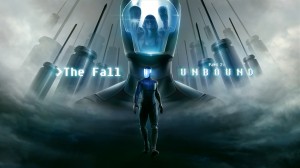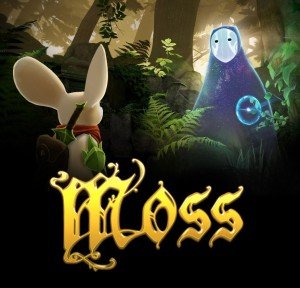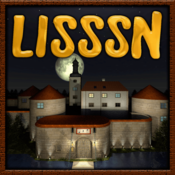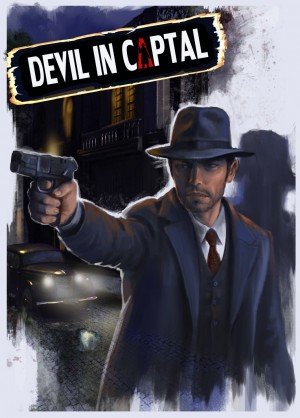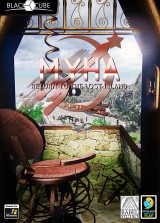Review for Dark Train

Have you ever wondered what it would be like to be a mechanical squid, tending a dilapidated cargo train as it races through a dystopian landscape in the rain? No, me either. But indie Czech developer Paperash Studio has in Dark Train, a game that's as hand-crafted and beautiful as it is enigmatic and mystifying. Part art experiment, part allegory, it's intriguing, occasionally frustrating, and wholly unique. It's tempting to draw comparisons with titles such as Samorost or Machinarium, but Dark Train makes both of those seem like beacons of simple clarity by comparison. If you love intricate plots and characterization, you should probably look away now, but those who just want a dramatic new world to play and tinker in are likely to enjoy this ride.
The first thing Dark Train greets you with is a small blue heart in the middle of an otherwise blank screen. That's it. Do nothing, and it'll just sit there like that. If you give in to curiosity, though, and click on the heart, you're rewarded with a single whump sound that's just a little like a heartbeat. Interesting. What if you click again, maybe get a rhythm going? That turns out to be just the ticket. Now the view shifts to a small, angular chamber where you (a four-tentacled mechanical squid called Ann 2.35f) are struggling to escape from a much larger pair of pincers. Is that a metaphor for being born? Maybe; your guess is as good as mine. There's no time to dwell on that, however, because as soon as you squirm free and fly out the window, you find yourself in an abandoned train shed, tethered to an old-fashioned-looking train covered in sheets of corrugated metal in the middle of a lightning storm. What now? Hmmmm. Well, when you swooped past that sheet of metal, it jiggled a bit. Do you think there's any way to shake it loose...?
That, in a nutshell, is the experience of playing Dark Train: it's all about exploration and curiosity, with only the subtlest hints about what might be going on to guide you. This is one time I don't need to worry about spoiling the plot or the ending, because I couldn't honestly tell you much even if I wanted to. The story does come to a resolution that feels reasonably satisfying, and every so often there are flashes of something approaching meaning – enough to suggest that the developers, at least, know what's happening – but really, it's best to just go with the flow. Accept that you're a squid living in a world where you can fly through the air as if it were water and your lot in life is to get this train moving somehow, then just go from there.
Another distinctive aspect of this idiosyncratic title is the art style. Fittingly for a studio with the name Paperash, Dark Train feels like you're playing through an animated paper collage. Each screen is built up of multiple flat layers, each object a carefully-trimmed and delightfully-detailed piece of paper: simple lightly-crumpled grey for the mountains, lovingly-illustrated angular shapes for the buildings. Even the clouds of steam coming from the train's chimneys are pieces of paper, pinned to the chimney top so they can blow in the wind.
Despite this paper-based aesthetic, , much of it is made to feel like metal, and everything has a realistic weight to it: sheets of iron shake and clank on their chains as you nudge them, and you fly with believable momentum. Sometimes you can see the chains the clouds in the sky are hanging from, and the waves in one scene are serrated steel sheets, swinging back and forth. All these hard lines and edges are then softened by the glow of lights in windows, shafts of sunlight coming through holes in the ceiling, and showers of rain or snow. Some elements, such as a pair of chandeliers, are drawn in ink, while others, such as drifts of fallen leaves, feel like tiny stencilled pieces of tissue paper.
All this comes together to create a carefully-crafted steampunk world that's (at least on the surface) dark and industrial, full of factories and smoke, girders and airships and glowing blue electric lights. The train, though, plays host to its own internal world, where you're finally free and unchained. Whether these scenes are somehow real or metaphors for the train's internal workings, they are often more rural in nature, with no outward sign of the steel and rivets that presumably still surround you in the world outside. There's a church surrounded by trees shedding their autumn leaves, a forest with ponds and glowflies and stars above, and a stark, snowy hillside overlooking the city. Time must also pass differently here, as you find yourself re-visiting the same places in winter, spring, or autumn, often in rapid succession.
There’s a nice contrast between the exterior world’s frantic locomotion, with its permanently overcast skies and endless grimdark cityscape whipping past at high speed, and the peaceful eclectic areas inside. While you do spend some time tending to the train, harvesting rainwater, charging the batteries, and rearranging the containers it carries (somehow changing both the places you visit and the season), the core of the game lies elsewhere. Despite the hyper-kinetic premise, this is actually a very laid-back, relaxed experience, spent quietly exploring, either within the train or occasionally outdoors when it stops at a station. Even when the train’s in motion, it’s really the world that’s moving around you, as the train itself mostly stays still in the middle of the screen. There are only a handful of moments when there’s any real feeling of tension, such as when you have to fend off a small, aggressive train that comes up behind you, but they’re fleeting, soon forgotten in the face of the charming scenes around you.
The action is accompanied by a minimal soundtrack, consisting mostly of rustling, clanking and chugging set against a steadily-rumbling storm and occasional ambient chords to set the mood. Overall the result is simple but effective, fitting better with the peaceful, meditative mood of the game than, say, a lush orchestral soundtrack would have done. There's not only no voice acting here, there's no language at all, unless you count occasional company names on buildings – even the menus are pictorial. Again, that suits Dark Train’s air of mystery and strangeness, teasing you with meaning but leaving you to make of it what you will.
The interface is similarly basic. Moving the mouse pulls Ann around the screen, like a cat chasing an unseen laser pointer. Left-clicking (and sometimes holding the button down while you move) interacts with hotspots, though you won't know what things are interactive until you try, and right-clicking brings up a menu to adjust settings or exit. Your interactions feel very physical, from clicking switches and turning knobs with a tentacle to flying around to herd glowflies. There's no inventory as such, although on a few occasions you do gather objects from the environment. To use these in the same area, you can click and hold to grab them in your tentacles and fly them where they need to go. If used elsewhere, a giant mechanical claw crane swoops down from the sky to whisk them away and then returns them to you when required. Sometimes you'll need to go to a shop that exchanges some of the objects you've gathered for others.
This all works well for the most part, although some areas can be tricky to navigate because they have several layers. You mostly fly around at the same depth, but sometimes you need to get at things that are further back on a more distant plane. At one point in a church, for example, I initially flew right past a chain that I needed to pull, taking a while to realise that I had to first go to a particular spot to make Ann fly deeper into the structure to access it. One of the low points of the game (at least for me) was having to navigate an ice maze covering a ruined city to get a part I needed. This involved several layers of ice with only subtle distinctions to show where the boundaries were, no obvious way to find how to get from layer to layer, and not even any clear indication of which layer the part I needed was actually on. Fortunately, such frustrations are the exception rather than the rule.
That sequence is, however, part of a more general issue with this type of exploration-based gameplay: it's not always apparent what you can interact with, what you can then do with it, or even what kinds of steps might be useful to take. It's to Dark Train's credit that I didn't often get stuck, but every so often it took me a while to realise that (for example) flying past those stars in the sky would let me draw shapes in the constellations, and that doing so might be a useful thing to do.
In a world that's this whimsical and strange, where pretty much anything can happen, I'd really have appreciated some kind of system that subtly highlighted points I'd missed. When you're expected to hang the moon in the sky, then find a way to cast its image on the lake below, all in order to complete the scene and trigger something else unexpected to happen, a little guidance here and there would have gone a long way. Then again, this isn't a game for those in a hurry: although you could probably get through it in less than two hours if you knew exactly what you were doing, it took me more like five to explore it all, and I rarely felt like I was just spinning my wheels.
Despite all the apparent randomness, there is nonetheless a sense of progression and purpose. The train starts out more or less completely non-functional, and it's your job to first get it moving, and then to get more and more of its systems working, finding ways to achieve tasks like replenish the batteries or water supply before other challenges come along for you to overcome. Through experimentation, these objectives become puzzles to solve as you work out the logic behind what you see and plan out ways to make something happen.
Sometimes these tasks are almost mundane, such as operating an ironworks to cast parts you need elsewhere, while others involve hunting down a vampire bat for its jewelled eye, shooting pieces of debris out of a tornado with bolts of lightning, and persuading a giant crab to play nutcracker. For the collectors out there, a number of screens also feature hidden (and sometimes tricky to obtain) boxes that reward you with blueprints for parts of the game.
Ultimately, Dark Train is (appropriately) about the journey, not the destination. Ann grows over time, evolving from initially struggling to get the train working to mastering its systems and occasionally helping out those she passes. She has a nest on board that gradually develops to feel like home, and she even gets a tattoo at one point. And all the while she's exploring the magical worlds inside the train, drawing Sputniks in the sky, getting chased by mechanical sharks, and playing a spider-silk harp.
At times it feels like you're acting out a play written in an alien language, meaningful in a way you don't quite understand; at others, it's enough just to play and be rewarded with the sight of the sun shining through an ice-encrusted church or a port city that looks a little like a steampunk Venice by moonlight. The world, too, is full of startling contrasts between a grey industrial reality with a strong flavour of Cold War Eastern Europe and an indoor fantasy world that is still often quite dark (what with the vampire bats and sharks) but can also be beautiful and allows Ann to exist unbound. These experiences, not simply getting to the end of the line, form the game's heart.
Dark Train is quite unlike anything else I've ever played, conjuring up a darkly magical vision of life beyond the Iron Curtain that could so easily have come across as grim and grey, but transcends that to showcase how wonder and imagination can still flourish, even in an industrial wasteland dominated by work and duty. It can perhaps be a little too abstract at times, leaving you confused and directionless, and its meaning is for you to decide, but the experience is undeniably memorable and enchanting. If you're in the mood to be taken somewhere new and different, I can definitely recommend boarding the Dark Train.












